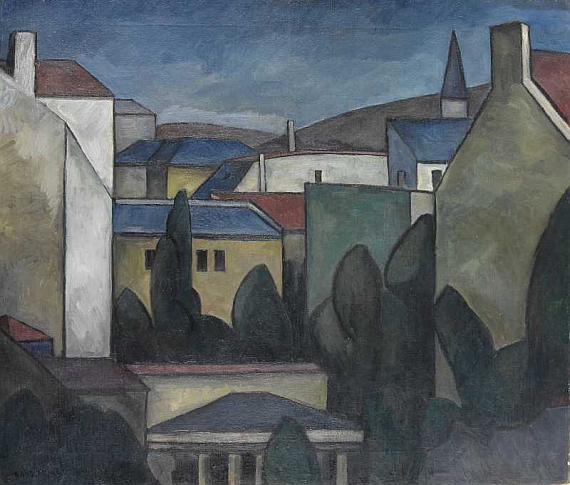
146
Alexander Kanoldt
Häuser, 1913.
Oil on canvas
Estimate:
€ 30,000 / $ 33,000 Sold:
€ 40,260 / $ 44,286 (incl. surcharge)
Oil on canvas
Signed and dated lower left. Once more signed and dated on stretcher. 68,5 x 81 cm (26,9 x 31,8 in)
PROVENANCE: Galerie Neue Kunst Hans Goltz, Munich (with label on stretcher).
Private collection South Germany.
EXHIBITION: Alexander Kanoldt 1881-1939, Gemälde - Zeichnungen - Lithographien, Museum für Neue Kunst, Freiburg/Von der Heydt-Museum der Stadt Wuppertal, 1987, cat. no. 21 (with illu. p. 111).
Schwabing - Kunst und Leben um 1900, Münchner Stadtmuseum, 21 September - 27 September 1998 (with illu.).
LITERATURE: Deutsche Kunst und Dekoration 34, 1914, illu. p. 328.
Alexander Kanoldt was born in Karlsruhe on 29 September 1881 the son of the late classicistic landscape painter Edmund Friedrich Kanoldt. He began an apprenticeship as a decorative painter at the local School of Arts and Crafts at the age of eighteen, but decided to join the Academy of Fine Arts in 1901. Kanoldt acquired the first basics of painting with Ernst Schurth and became friends with his fellow student Adolf Erbslöh. During this time Kanoldt closely studied Neo-Impressionist techniques, which inspired his technically extremely sophisticated color lithographs. In 1904 Kanoldt continued his studies in Friedrich Fehr's painting class and became his master pupil between 1906 and 1909. Kanoldt moved to Munich in 1908, where he founded the 'Neue Künstlervereinigung' (New Artists‘ Acsociation ), a forerunner of the 'Blauer Reiter' (Blue Rider ), together with Alexej von Jawlensky, Wassily Kandinsky, Gabriele Münter and others one year later. Kanoldt also took part in their first exhibition at Heinrich Thannhauser's ‘Moderne Galerie‘ (Modern Gallery ) in Munich in 1909.
Kanoldt lived on Nikolaiplatz in Munich-Schwabing from 1910 to 1911. He makes several drawings of this square with alternating architectural details. The clearly contoured objects make for an austere view over the roofs of Sachwabing. The hushed chromaticity is inspirited by the subtle nuances in the single fields. Thus a magic aura is created despite the sober depiction.
In 1913 Kanoldt, as well as Bechtejeff, Karl Caspar, Jawlensky and Paul Klee, was a member of the "Münchener Neue Sezession" (Munich New Secession ). Kanoldt's artistic career was interrupted by the outbreak of the war during which, from 1914 to 1918, Kanoldt served as an officer. During a longer stay in Italy in 1924 Kanoldt produced multi-perspective architectural landscapes and serene interiors. This picture already hints at this later period of creation. These works mark a new beginning in Kanoldt's work and result in an invitation to exhibit works in the "Neue Sachlichkeit" (New Objectivity ) exhibition in 1924 at the Kunsthalle Mannheim. His was the second largest group of works after Max Beckmann. In 1925 Oscar Moll appointed him to teach at the Breslau Academy, a post that he gave up again in 1931. In 1932 he joined the Munich artist group "Die Sieben" (The Seven ) and exhibited at their shows. Even though he was appointed professor at the Academy in Berlin in 1933, his works were labelled "degenerate" by the Nazi regime and confiscated in 1937. For health reasons he had been forced to give up his post in Berlin one year before. Alexander Kanoldt died of a heart disease in 1939. [EH].
146
Alexander Kanoldt
Häuser, 1913.
Oil on canvas
Estimate:
€ 30,000 / $ 33,000 Sold:
€ 40,260 / $ 44,286 (incl. surcharge)


 Lot 146
Lot 146 